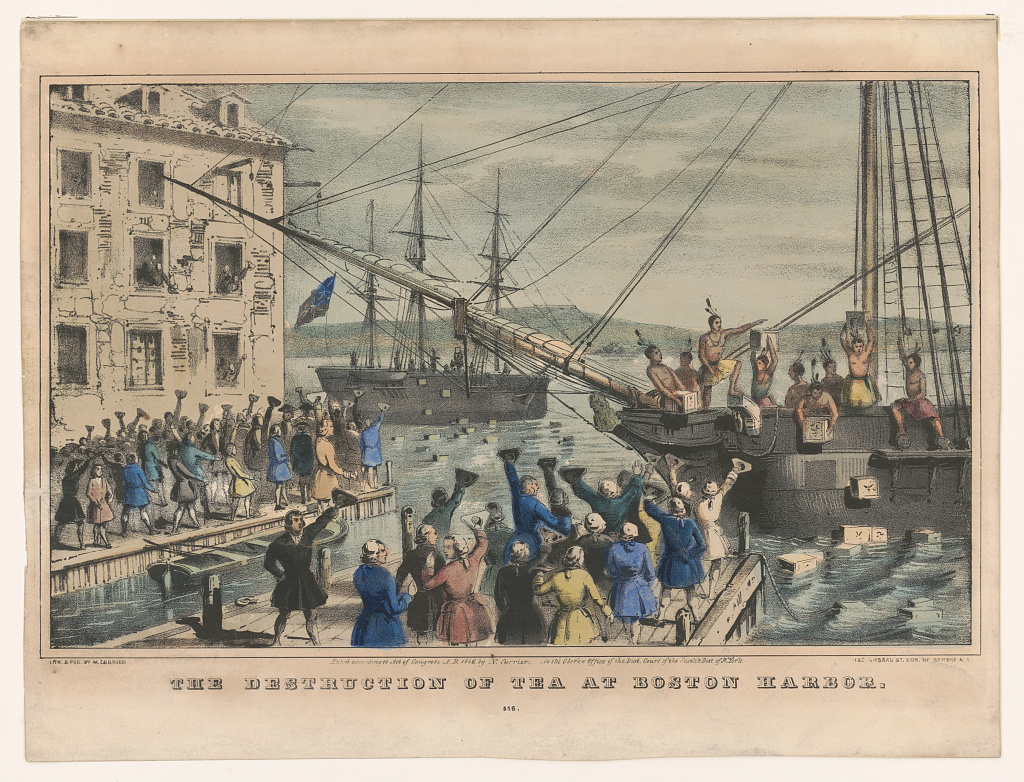Note: The following is the eleventh and final post in a series that presents my attempt to answer the question, “How does history connect Westborough and India?” See the Introduction for an overview of the series and to start reading it from the beginning.
–Anthony Vaver, Local History Librarian, Westborough Public Library
Separation
The Great Rebellion of 1857 in India ultimately failed due to a lack of organization and institutional structures to sustain it. But the American colonies were well positioned to carry out rebellion against the British government and rule themselves once they separated from England. Westborough and other towns in Massachusetts had their own sets of laws, self-rule in the form of town meetings, elected representatives to the House of Representatives, and their own militias. During the American Revolution, more than a hundred Committees of Correspondence were set up, including one in Westborough, which served as an informal shadow government to carry out rebellion and ultimately revolution. After both the signing of the Declaration of Independence by the Americans on July 4, 1776 and British defeat in the resulting war, England turned its attention to defending its colonial interests in India and other colonies throughout the world.
In 1885, the Indian National Congress was formed to advocate for Indian home rule, and when Mahatma Gandhi became its leader in 1920 he began to mobilize it into a body of resistance under a doctrine of “non-cooperation.” Gandhi and other Indian nationalists studied the tactics and read the treatises that led to the American Revolution for inspiration when they organized boycotts, shutdowns, demonstrations, and tax protests. Mahatma Gandhi’s famous “salt march” to the sea to collect salt in protest over its taxation by the British was one such protest. Gandhi also used the symbolism and economic significance of cotton to galvanize nationalist and anti-colonial sentiment by both writing a history of cotton in India and practicing the spinning of cotton on a wheel as a means of publicizing India’s potential to reclaim its dominant position in the global economy from its British oppressors.
In the end, the strains of World War II on Great Britain ultimately led to India’s separation from the British Empire and its independence. During negotiations over the future of Indian rule in 1947, the two dominant political parties, the Indian National Congress and the Muslim League, could not agree on a common future. The League insisted on carving out part of India to create a separate Muslim nation, which ultimately became Pakistan. The inability to keep India together as one nation resulted in mass displacement, plunder, and revenge killings with over 1 million people dying and more than 12 million being forced from their homes before it was all over.

(Westborough Town Clerk, http://repository.westborougharchive.org/files/original/700d82def53c4ac7be6098193541cdf0.jpg)
The Boston printing of the Declaration of Independence was circulated to towns across Massachusetts and included an order at the bottom for town clerks to copy the content of the document into their town records. Above is Westborough’s hand-written copy.

(Wikimedia Commons, https://commons.wikimedia.org/wiki/File:Gandhi_during_the_Salt_March.jpg)
In an act of civil disobedience against the heavy taxation of salt by the British, Gandhi organized a widespread protest march to the sea to collect salt through evaporation in violation of the salt laws.

(Wikimedia Commons, https://commons.wikimedia.org/wiki/File:Gandhi_spinning.jpg)
As a reminder of India’s history of once being the dominant producer of cotton cloth throughout the world, Gandhi held cotton spinning demonstrations and encouraged others throughout India to take up the practice.
* * *
Social and political tensions created during British rule in both India and the United States continue to be felt today. In India, violent conflict played out almost immediately during the partitioning of the country into India and Pakistan in 1947, and struggle between the two countries over control of Kashmir continues to this day. In the United States, tensions over slavery lingered for decades until they finally came to a head with the outbreak of the American Civil War. But the social, political, and cultural differences that initially led to this conflict in many ways remain unresolved. Westborough and India no longer fall under British rule, but the common history we experienced under that rule continues to reverberate and connect us, even though geographically we sit at opposite sides of the globe.
This concludes the series of posts on “How Does History Connect Westborough and India?”
Westborough-India Series Bibliography
Beckert, Sven. Empire of Cotton: A Global History. New York: Vintage Books, 2014.
Bunker, Nick. An Empire on the Edge. New York: Vintage Books, 2014.
Collingham, Lizzie. Taste of Empire: How Britain’s Quest for Food Shaped the Modern World. New York: Basic Books, 2017.
Darwin, John. Unfinished Empire: The Global Expansion of Britain. New York: Bloomsbury Press, 2012.
Eacott, Jonathan. Selling Empire: India in the Making of Britain and America, 1600-1830. Chapel Hill, NC: U of North Carolina P, 2016.
Frankopan, Peter. Silk Roads: A New History of the World. New York: Vintage Books, 2015.
Freeman, Joshua B. Behemoth: A History of the Factory and the Making of the Modern World. New York: W. W. Norton & Company, 2018.
Schama, Simon. Civilizations. PBS television series, 2018. http://www.pbs.org/civilizations/home/.
Vaver, Anthony. The Rebellion Begins: Westborough and the Start of the American Revolution. Westborough, MA: Pickpocket Publishing, 2017.
Wilson, Jon. The Chaos of Empire: The British Raj and the Conquest of India. New York: Public Affairs, 2016.

















